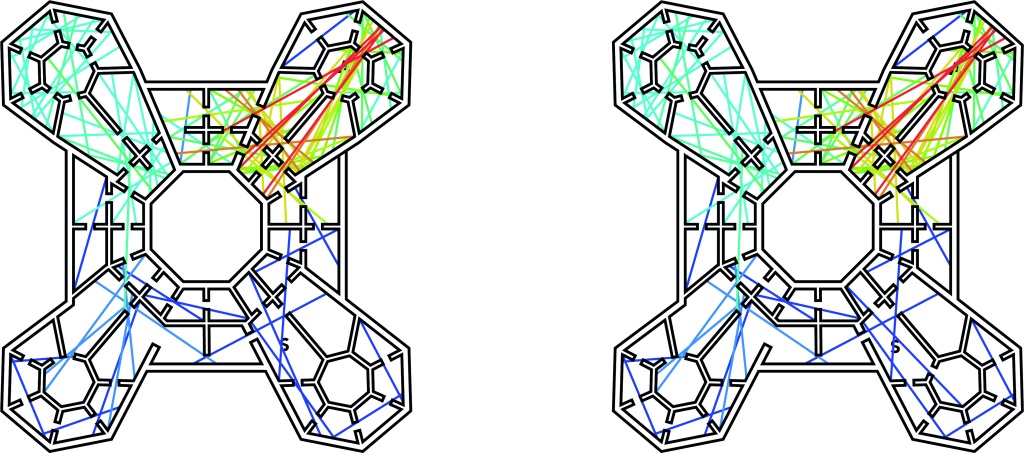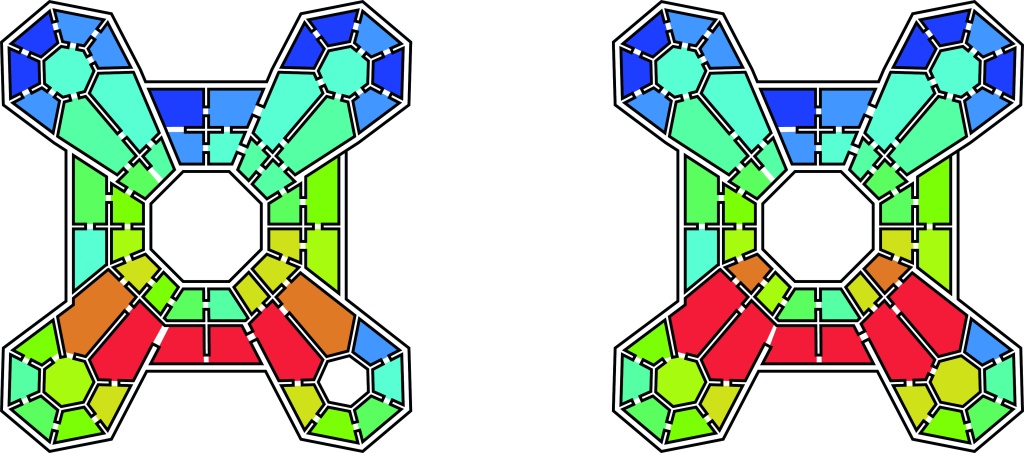If architecture creates stories, can stories create architecture? So the essay of Mariana Garcia Fajardo – a student in my Architectural Phenomena module in the SSAC MSc at the Bartlett School of Architecture, UCL – begins addressing Umberto Eco’s design of the library in his acclaimed novel The Name of the Rose. For Mariana, the library possesses key spatial organizational and compositional features related to ‘spatial meaning and functions as a complex symbolic form’. In their paper ‘The Spatial Construction of Seeing in Castelvecchio’, Gianna Stavroulaki and John Peponis illustrate the interrelationships of the experience lived within space through movement and the symbolic function of the gallery’s display in Carlo Scarpa’s adaptation of the medieval castle to a gallery. Mariana asked: if layouts have the capacity to express symbolic meanings through the conceptual structure of a display in a real museum, and the organisation of knowledge in a library , can the spatial layout of the fictional library in Eco’s novel point to a relationship between real-life spatial configurations and fiction?
Furthermore, what is the spatial narrative of the library?

When Mariana approached me to discuss Eco’s use of space in The Name of the Rose, I realised that she had touched upon the core question of the relationship between space, language and knowledge. She was inspired by Stavroulaki and Peponis’ study of the Castelvecchio and the idea that buildings that contain and structure knowledge have a symbolic function. Like the sculpture gallery at Castelvecchio, Eco’s library does not seem to have a specific ‘pattern of exploration’. Nevertheless, in penetrating the labyrinthine layout, the protagonists, William of Baskerville and Adso of Melk, find out that its spatial layout reassembles a map of the world. The books in the library are classified according to the geographical place they came from. In consequence, they discover a hidden room within the library: the finis Africae with its own secret entrance. Within the library, the relationships between the rooms are as important as the library itself. The library is a physical and metaphorical fortress, through the defensive appearance in the exterior and its labyrinthine interior, which contains a secret room and forbidden books. By analysing the library’s layout, it is possible to display the spatial narrative of the finis Africae.

By representing spatial arrangements of buildings, from modern, anthropological, archaeological and historical sources, by the means of graphs, Bill Hillier, Julienne Hanson and their colleagues at UCL have been studying the spatial configuration of different building types over 40 years. Looking at the interconnections of the rooms in the graph of the library, Mariana revealed that the entrance to the library through room A – located in the eastern tower- is not only the main access, but also the entrance to a world where the power of knowledge resides. Besides, the entrance is located within the sequence marked as fons adae, which translates to the ‘origin of Adam’ or ‘earthly paradise’. According to Edson, ‘since it was believed that man would never re-enter the earthly paradise, this map was plainly not designed for travel, but for contemplation’.

The axial analysis of the plan based on the longest and fewest axial lines that cover all possible spatial connections shows that the straight visual lines covering the origin of the world (room A) are the most integrated lines compared to the rest of the lines covering the rooms that stand for different geographical regions. The fons adae is not only the entrance to both the physical world and the world of knowledge in the novel, but also proves that spatially is indeed the room that best connects the entire structure. The justified graph with the finis Africae at its root (where the secret entrance to the library is located) shows a less deep layout, known only to Jorge de Burgos, the blind librarian who is guarding the library’s secrets.

Using the room as the unit of analysis one sees that the finis Africae is next to the most integrated spaces. This is a clear case of power relations are embedded in the spatial arrangement of the library. The most accessible parts, reached through a secret entrance by the librarian, are difficult to reach by the visitor who is only aware of the northern entrance. Shielding away Aristotle’s second book on Poetics alongside books of ‘fantastic animals and beasts’ constructing combinatorial worlds of the possible, the finis Africae remains out of reach by the uninitiated monks, and by William and Adso who break the monastery laws entering the library. This resonates with the librarian’s need to control access to books, particularly to the ‘false’ books of the possible’, by a labyrinthine sequence of rooms and a locked chamber.

Mariana has uncovered that Eco’s understanding of the library as a labyrinth was not only one of content, but also one of substance. The library and the most inaccessible room inside it are impenetrable not only because the story says so, but also because of the way in which Eco has designed its spaces. Various authors have commented that Jorge de Burgos is modelled after Jorge Louis Borges, the author of The Library of Babel, a model for the cosmos based on a maze-like library housing incomprehensible books. Borges was also blind and served as the chief librarian of the National Library of Argentina. His attraction to labyrinths found expression in his short detective stories, while his erudition and interest in theories of knowledge enabled him to make intellectual and cognitive links between language, knowledge and space.

Mariana concluded that similarly to Carlo Scarpa’s design of Castelvecchio, the library in The Name of the Rose has a meaningful and complex layout. A correspondence between different features of its spatial arrangement and book content shows there is a relation between real-life spaces (museums) and fictional spatial configurations (the library). The library’s paradox is that it is both a labyrinth and a map. The visitor can solve the labyrinth by understanding the map that lies within it.
It is not suggested that Eco knew of the graph structure of his library, but somehow he got content (the labyrinth he wrote about) and substance (the setting he designed for the characters’ action) to be aligned with each other.
As William, the tutor, and Adso, the novice, advance deeper and deeper inside the library, William explains that ‘books are not made to be believed but to be subjected to inquiry’, summarizing the core message of the novel – and a powerful message for students. Mariana’s inquiry of the library is not about what the novel says or expresses about the layout, but what the layout does and what it means as a system of spatial interconnections and associative relationships between spaces, language (the novel), the organization of books (knowledge) and the map of the world, a constellation of other systems and signs.
References
Mariana Garcia Farjado, The Name of the Rose by Umberto Eco: Spatial theories and spatial organization as literary features, Essay submitted for the Architectural Phenomena module, January 2020.
Eco, U., 1993. El Nombre de la Rosa. Barcelona: RBA Editores S.A.
Edson, E., 1997. Mapping Time and Space: How Medieval Mapmakers Viewed Their World.
London: British Library.
Hillier, B. Hanson, J., 1984. The Social Logic of Space, Cambridge: Cambridge University Press.
Hillier, B., 2007. Space is the Machine. London: Space Syntax.
Peponis, J. & Hedin, J., 1982. ‘The Layout of Theories in the Natural History Museum’. 9H,
Issue 3, pp. 21-25.
Stavroulaki, G. & Peponis, J., 2003. ‘The Spatial Construction of Seeing at Castelvecchio’. In:
Proceedings of the 4th International Space Syntax Symposium. s.l.:UCL, pp. 66.1-66.14.The Spatial Construction of Seeing at Castelvecchio
